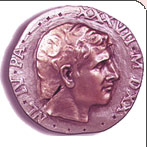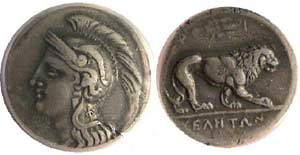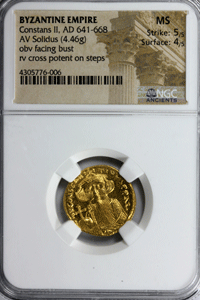Ancient Coins
Ancient Coins Collecting is a challenging task, but it's the best way to enjoy and learn history of ancient civilizations.
As everyone knows, coins are a form of money or medium of exchange. In addition to coins and paper currency as we now know them, a wide variety of items have been used as money at different times in history, both prior to and after the invention of coins.
These items have included, beads, cigarettes, feathers, ivory, cattle, salt, shells, thimbles and wampum.

Ancient Greek Coins
The minting of coins spread rapidly from Lydia to the city states of ancient Greece. Around 600 BC , the island of Aegina produced what are believed to be the first Greek coins. These coins were known as silver drachmae and obols and depicted a turtle on the reverse, the symbol of Aegina.
The nearby Greek city state of Cornith soon followed Aegina and produced drachmae coins with the legendary figure of the winged horse Pegasus on the reverse.
The largest of the Greek city states was Athens which around 610 BC began producing very artistic coins often featuring an amphora or wine vessel design.
Alexander the Great (336-323 B.C.) established the practice of coinage throughout the Hellenic empires. His successors introduced portraits as a regular feature of their coinage designs thereby recording for posterity many images of ancient kings and rulers.

Athenian Didrachm
Ancient Roman Coins
The Romans were the next major state to establish coinage on a large scale.
It is usual to date the first Roman coins from 269 BC when a mint for the striking of gold, silver and bronze coins was established in Rome.
Ancient Roman coinage often depicted a portrait of the then ruling emperor and, in some cases, members of the imperial family as well. These Roman "portrait" coins were skillfully engraved and are wonderful pieces of art and of interest to the historian.
Early Roman coins were often employed to disseminate political propaganda.
The inscriptions on the reverses of the coins frequently proclaimed the emperor's civic achievements or military triumphs. In some cases, very important events, such as the assassination of Julius Caesar, were depicted on the coinage.
Ancient Chinese Coins
It is hard to overstate the problem. The current market is overrun with fakes of ancient Chinese knife, spade, cash, and related cast bronze objects. Since about 1985 forgers in the PRC have developed new techniques in the service of faking bronze vessels and other antiquities of high value.
These techniques are easily applied to coins. Reportedly, dealers will take rare coins to these factories where they are reproduced, with the correct metal composition, patination color and type of soil adhesion proper to that dynasty and type. Traditional methods of forgery detection are impotent against these fakes, and the problem now extends down to some fairly inexpensive items.
Read more here.
Ancient Gold Coins
 With the latest ancient coin grading program provided by NGC - NGC Ancients you can finally have a collection of ancient coins with a piece of mind. You can purchase more than one thousand years old coin full of original luster from the online auction site, such as an Ebay at the comfort of your home. This opens new opportunities for ancient coin collectors who would like to have a collection of beautiful golden Roman empire coins.
With the latest ancient coin grading program provided by NGC - NGC Ancients you can finally have a collection of ancient coins with a piece of mind. You can purchase more than one thousand years old coin full of original luster from the online auction site, such as an Ebay at the comfort of your home. This opens new opportunities for ancient coin collectors who would like to have a collection of beautiful golden Roman empire coins.
NGC Ancient uses a new grading system and in the circulated grades strictly describes the amount of wear a coin has suffered; however, in the uncirculated grades it will take into account the overall appearance of the coin to distinguish among Mint State, Choice Mint State and Gem Mint State.
See our Coin Grading section for more information about Ancient Coin grading.
Ancient coin education
You would need to have a latest information to make sure you are buying something valuable when considering buying ancient or antique coins. Forums are best source of this information, since they constantly get updated and reflect the best the concerns and useful information about coins.
Here are some of the forums, which you can find useful:
FORVM Ancient Coins

